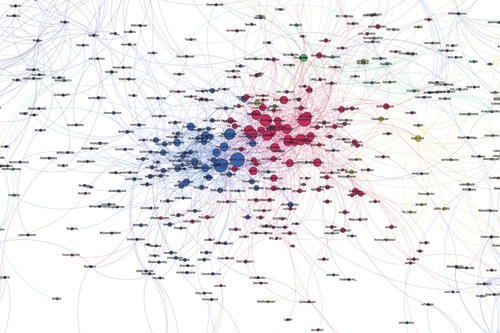
A friend at a pharmaceutical company recently told us of her frustration when trying to find healthcare influencers. She had been keen to identify individuals who shaped online opinion within her therapy area – diabetes – so that she could understand what online audiences considered important. She asked an agency to research the most respected individuals in the area. Rather than naming one of the many informed, knowledgeable people who talk about diabetes online, the agency identified a single ‘influencer’, British television host Davina McCall. The reason? She had once mentioned diabetes on Twitter, and has 1.7 million followers.
Traditionally, key opinion leader (KOL) identification relied on personal opinion or brute-force bibliometrics. It is based on reputation or visibility at congresses, or simply counting up how much a KOL has published on a given area. However, these methods are crude – they tend to prize volume over quality, and are vulnerable to bias and personal opinion.
As our friend found, in the world of social media the picture is no clearer. Influence is big business, and companies like San Francisco-based Klout have attracted attention – and venture capital – with their promise of being able to spot and quantify this powerful elixir. These companies keep their algorithms secret, but they often work by multiplying each user’s reach (eg follower count) by the number of times he or she mentions a subject. The problem is that ‘bots’ – Twitter accounts controlled by programs, which tend to robotically churn out content and are followed by other non-human accounts – rank highly, as do celebrities who mention a subject occasionally but have no real interest or commitment to the therapy area.
What is influence?
A key insight is that influence is always community specific. A doctor may be genuinely influential amongst his peers, but transplant him to Twitter and he might struggle to attract followers. Similarly, the opinion of a patient blogger may be respected by others talking about a therapy or disease online, but at a medical congress, or as an author on a scientific paper, that person’s opinion is unlikely to hold as much weight.
But this effect goes beyond platforms. Influencers are also always topic specific. Even influential doctors only tend to be influential on a specific subject – rarely do professors of oncology, for example, hold much sway amongst those who spend their lives treating bipolar depression. That is a very crude example, but influence is far more specific than that. There are influencers for such specialised subjects as the relative merits of various quality of life scales, or DPP-IV inhibitors, or patient adherence to HIV medications.
Social network analysis
You already rely on network analysis several times a day but may not be aware of it. It lies behind Google’s uncanny ability to pick out the most relevant web page among thousands, Facebook’s suggestions of potential ‘friends’ that you actually do already know, and Amazon’s very relevant (and lucrative) recommendations of that next book or album.
A very simple principle lies behind network science. It works by modelling complex phenomena as networks: so ‘nodes’ are things like people, products, or web pages; and the links between them, or ‘edges’, are relationships or associations of some kind, such as a hyperlinks or collaboration on a project.
The central insight of network analysis is that a node’s position in the network determines how important that node is – so for example if a website (a ‘node’) is linked to (has ‘edges’ from) lots of other websites, it is considered influential. If those linking websites are themselves well linked to, your website is even more ‘central’ to the network and thus can be considered even more influential. When this principle is applied by Google, the end result is that the Wikipedia page sits at the top of your search results, while the obscure blog that your aunt runs on the same subject struggles to appear within the first 10 pages. (In fact, the sophisticated networks Google models take account of the relationships it knows its users have – from Gmail, Google+, etc – so it may well rank your aunt’s page highly, but only for you!)
Network analysis lies behind Google’s uncanny ability to pick out relevant web pages among thousands
Once you’ve modelled a network you can explore many other factors, such as how easily or quickly information flows through it, or how ‘robust’ (resistant to change) it is. Network analysis can help an epidemiologist see who in a network of ‘susceptibles’ should be prioritised for vaccination, or help an HR department visualise whether two divisions are working as silos with no meaningful communication between them.
Mapping medical influencers
You may think it would be impossible to model practising doctors and scientists as a network – after all, we can’t quiz each and every one of them about who they know, respect, or work with. But in fact the tool we have developed makes it relatively easy to do this – and in the process allows us to focus on those who are really creating and shaping opinion.
Our insight came when we realised that every paper published in any bioscience journal is, in effect, a small network. One can say with reasonable confidence that the authors are likely to know each other, most likely because they work in the same hospital or are members of the same research group. That network of authors on a single paper is not in itself very interesting. But cycle over tens, hundreds or even thousands of papers – with tens of thousands of co-authorship relationships – and you very quickly build a picture of a broader web of collaboration as authors appear on multiple papers, each time with a slightly different set of co-authors.
If we limit the papers we consider to those on a given topic, in effect we are building a co-authorship and collaboration network for that topic. The resulting network allows us to identify communities, connectors and – most importantly – influencers relevant to a therapy area, disease or treatment.
Of course the data isn’t perfect, and various subtleties of how doctors collaborate in real life may not be captured in the medical literature. But when data is processed on this massive scale minor variations are evened out, the big picture begins to emerge, and we can gain insights that don’t appear in more limited analyses. In the words of an article by three big data pioneers at Google, this approach allows us to make use of the ‘unreasonable effectiveness of data’.
Mapping healthcare influencers online
The network-mapping approach finds its natural home, of course, online, and it is also possible to map the communities that gather around health topics on platforms such as Twitter.
Physician networks tend to reflect real life – publication communities will tend to mirror brick-and-mortar communities such as hospitals – and influencers identified by the literature will probably also hold high-status positions at these institutions. But life online is much more frictionless. In Twitter, we see that communities tend to form around topics and opinions, with factors like geography, offline status and stage presence holding less weight.
For this reason, influence on Twitter is mostly fuelled by the content an individual shares – whether that’s defined as the attitudes he or she has, the language he or she uses, or the links he or she shares. Because of this, identifying influencers on Twitter can give us really important insights into what content we should create, and how. These insights ensure our content is likely to be useful to – and shared by – the community we are interested in. They can also, of course, help us understand how to become influential ourselves.
It’s easy to see why many of the tools that claim to identify influencers are so well used. They deliver quick, apparently useful, results, and it’s only when you dig a little deeper or try to act on the insights that you see how little foundation their recommendations have. But influence is something it’s worth taking the time to understand. We believe that robust, quantitative network analytics will revolutionise healthcare marketing in the same way it has revolutionised search engines, social media, and online shopping.





